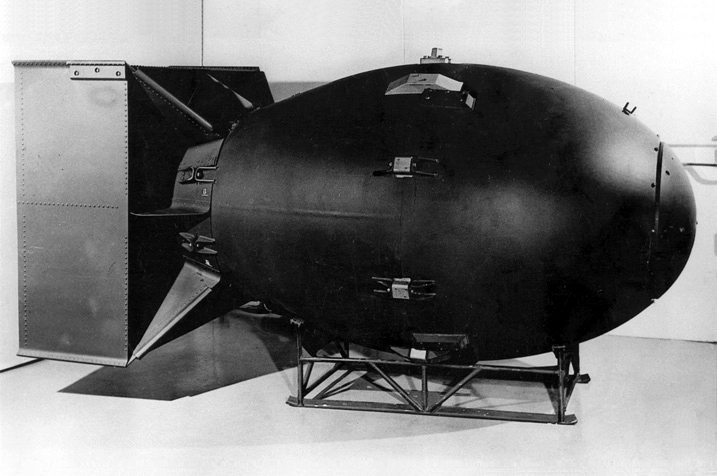Advancements Throughout History
This will be about Technological Advancements through out world history. We will be taking a look on a few of the inventions that helped shape western civilization. The things we look at will include, Steam Power, metal working machines, tanks, atomic bombs, and satellites.
Steam Power
The development of stationary steam powered engines was a fundamental step in the advancement of mechanical production. The first successful usage of a steam piston engine was implemented by Thomas Newcomen who designed it to be used in underground mining. His engine was able to produce 3.7kw (5hp) and a total of 110 were known to have been built. Steam power helped the speed of factory production and also helped in the mines. Below is a picture of Thomas Newcomens steam engine design.
- Steam Engines work when a liquid (usually water) witch is held in a still is vaporized under extreme heat then sent into a cylinder to build pressure and propel a piston witch then is attached to a series of weights and pules to power things.
New Machines
During the industrial revolution there was an increase in the demand for metal parts used in machines and products. This lead to the development of several crucial peaces of tools and machinery used in the manufacturing industry. Three of these machines were the milling machine, lathe, and the metal plainer. These new machines were developed so that they could be used to help manufacture new metal parts for machines and products.
Tanks
During the first world war trench warfare was a terrible thing. The British sought out to design an armored vehicle capable of maneuvering the harsh battlefield terrain, with the capability to be equipped with a multitude of weapons such as an artillery cannon and guns. Bellow is a photo of a British Mark 1 tank in 1916. The Mark 1 was the first tank ever to be used in a military operation. Tanks have impacted the way countries fight and has put an end to trench ware fare.

Atomic Bombs
Due to the immense power that nuclear weapons hold they create substantial political and military power. The control and position of nuclear power has been an issue for about as long as they have been around. During World war Two Canada, USA and the United Kingdoms collaborated in what was called the Manhattan project. It was an Implement to counter possible rumors of the Nazi Germany Nuclear Weapon program. Atomic Bombs changed the way the western world works because with them, we have imminent protection against any threats in the world.

Satellites
Satellites are an important part of western civilization because without them we would not have a lot of the technological capabilities that we have today. The first satellite was developed in Russia in 1957 and sent into earths orbit with the task of measuring atmospheric layers through changes in its orbital change. Russia's breakthrough in space technology prompted the United States to begun developing and testing their own satellites. The First idea regarding the use of satellites for the purposes of global communications can be related back to 1945 in a letter to the editor of Wireless World magazine. Then in 1960 NASA Launched the worlds first Communication satellite via an air balloon. This fundamentally helped pave the way to a new era of communications and wireless data transmissions. Today satellites are used for many purposes such as astronomical(looking for distant planets and space stuff), Communications, Navigational, Warfare and weather.

New Machines
During the industrial revolution there was an increase in the demand for metal parts used in machines and products. This lead to the development of several crucial peaces of tools and machinery used in the manufacturing industry. Three of these machines were the milling machine, lathe, and the metal plainer. These new machines were developed so that they could be used to help manufacture new metal parts for machines and products.
Tanks
During the first world war trench warfare was a terrible thing. The British sought out to design an armored vehicle capable of maneuvering the harsh battlefield terrain, with the capability to be equipped with a multitude of weapons such as an artillery cannon and guns. Bellow is a photo of a British Mark 1 tank in 1916. The Mark 1 was the first tank ever to be used in a military operation. Tanks have impacted the way countries fight and has put an end to trench ware fare.
Atomic Bombs
Due to the immense power that nuclear weapons hold they create substantial political and military power. The control and position of nuclear power has been an issue for about as long as they have been around. During World war Two Canada, USA and the United Kingdoms collaborated in what was called the Manhattan project. It was an Implement to counter possible rumors of the Nazi Germany Nuclear Weapon program. Atomic Bombs changed the way the western world works because with them, we have imminent protection against any threats in the world.

Satellites
Satellites are an important part of western civilization because without them we would not have a lot of the technological capabilities that we have today. The first satellite was developed in Russia in 1957 and sent into earths orbit with the task of measuring atmospheric layers through changes in its orbital change. Russia's breakthrough in space technology prompted the United States to begun developing and testing their own satellites. The First idea regarding the use of satellites for the purposes of global communications can be related back to 1945 in a letter to the editor of Wireless World magazine. Then in 1960 NASA Launched the worlds first Communication satellite via an air balloon. This fundamentally helped pave the way to a new era of communications and wireless data transmissions. Today satellites are used for many purposes such as astronomical(looking for distant planets and space stuff), Communications, Navigational, Warfare and weather.

By Jake Green






